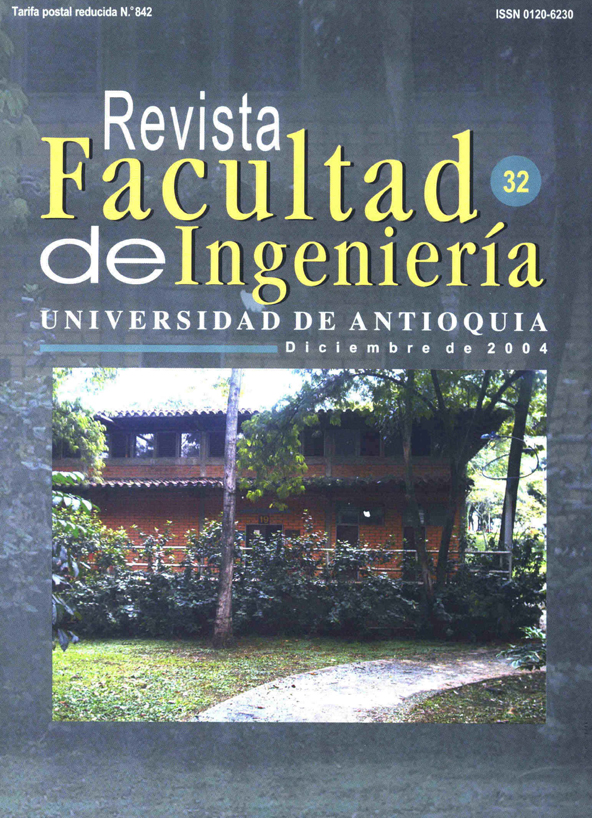Evaluación del efecto tóxico del acetato plomo y el cloruro de cromo sobre el metabolismo bacterial anaerobio
DOI:
https://doi.org/10.17533/udea.redin.344308Palabras clave:
toxicidad, reactor UASB, inhibición, metanogénesis, metales pesados, digestión anaerobiaResumen
Se presentan los resultados del estudio de toxicidad del cloruro de cromo (CrCl3) y el acetato de plomo (CH3COO)2Pb del lodo de un reactor anaerobio de flujo ascendente y manto de lodos (UASB), aclimatado y estabilizado en el laboratorio con una solución de suero en polvo sintético; los ensayos de toxicidad se realizaron en botellas serológicas de 60 mL, se utilizaron como sustratos soluciones de ácido fórmico y suero en polvo sintético y se ensayaron concentraciones de cloruro de cromo en el rango de 1.000 a 5.000 mg/L, y de 1.000 a 10.000 mg/L para el acetato de plomo. Durante 72 horas se valoró la producción de metano en mL y el comportamiento del potencial redox en mV. Se presentaron reducciones del 50% en la producción de metano a concentraciones de 3.322 mg/L para cloruro de cromo y 1.415 mg/L para el acetato de plomo cuando el sustrato fue ácido fórmico, y a 2.291 mg/L para el cloruro de cromo y 1.982 mg/L para el acetato de plomo cuando el sustrato fue suero en polvo sintético. En síntesis, el artículo demuestra que las bacterias metanogénicas tienen un grado de resistencia cuantificable con respecto a las diferentes concentraciones de metales aplicados.
Descargas
Citas
Zayed, G. y Winter, J. “Inhibition of methane production from whey by heavy metals. Protective effect of sulfide”. En: Applied Microbiology Biotechnology. N.° 53. 2000. pp. 726-731. DOI: https://doi.org/10.1007/s002530000336
Lester, J. Heavy metals in wastewater and sludge treatment processes. Editoral CRC Press. Boca Raton, 1987.
Lin, Chiu-Yue y Chen, Chin-Chao. “Effect of heavy metals on the methanogenic UASB granule”. En: Water Research. Vol. 33. N.° 2. 1999. pp. 409-416. DOI: https://doi.org/10.1016/S0043-1354(98)00211-5
American Public Health Association. APHA Standard methods for examination of water and waste water. 18th Ed. New York, 1992.
Saldarriaga, Julio. Evaluación de la presión selectiva y de la adición de bacterias liofilizadas como alternativas de mejoramiento de una semilla de lodo activado crudo espesado para el arranque de reactores UASB. Tesis de grado para optar al título de magíster en Ingeniería Ambiental. Universidad de Antioquia. Medellín, Colombia, 2000.
Bitton, G. Wastewater Microbiology. Ed. Wiley. New York, 1994.
Speece, H. Anaerobic biotechnology for industrial wastewater. Archae Press. Nashville, 1996.
Tinsley, I. Chemical concepts in pollutant behavior. Ed. Wiley-Interscience. Canadá, 1979.
Field, J. “Medición de Parámetros”. En: Curso: arranque y operación de reactores anaerobios con flujo ascendente y manto de lodos (UASB). Universidad del Valle. Cali, 1987.
El Bayuomy, Mahmoud et al. “Removal of heavy metals and COD by SRB in UAFF reactor”. En: Journal of Environmental Engineering. Vol. 25. N.° 6. Junio, 1999. DOI: https://doi.org/10.1061/(ASCE)0733-9372(1999)125:6(532)
Li, B. y Bishop, P. Oxidation-reduction potential (ORP) in regulation of nutrient removal in activated sludge wastewater treatment plants.
Balch, W. et al. “Methanogens: revaluation of a unique biological group”. En: Microbiology Reviews. N.° 43. 1979. pp. 260-296. DOI: https://doi.org/10.1128/MMBR.43.2.260-296.1979
Descargas
Publicado
Cómo citar
Número
Sección
Licencia
Los artículos disponibles en la Revista Facultad de Ingeniería, Universidad de Antioquia están bajo la licencia Creative Commons Attribution BY-NC-SA 4.0.
Eres libre de:
Compartir — copiar y redistribuir el material en cualquier medio o formato
Adaptar : remezclar, transformar y construir sobre el material.
Bajo los siguientes términos:
Reconocimiento : debe otorgar el crédito correspondiente , proporcionar un enlace a la licencia e indicar si se realizaron cambios . Puede hacerlo de cualquier manera razonable, pero no de ninguna manera que sugiera que el licenciante lo respalda a usted o su uso.
No comercial : no puede utilizar el material con fines comerciales .
Compartir igual : si remezcla, transforma o construye a partir del material, debe distribuir sus contribuciones bajo la misma licencia que el original.
El material publicado por la revista puede ser distribuido, copiado y exhibido por terceros si se dan los respectivos créditos a la revista, sin ningún costo. No se puede obtener ningún beneficio comercial y las obras derivadas tienen que estar bajo los mismos términos de licencia que el trabajo original.










 Twitter
Twitter